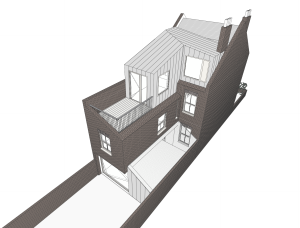Converting your loft can be good value for money when improving your home and increasing your living space. An L-shaped dormer loft conversion can be a good option for creating more room at the top of your home. Popular on period, terraced properties, this type of loft conversion creates a lot of space, usually adding at least a couple of rooms to your property. In this post, we give you a bit more information about what is involved in this type of conversion.
What does ‘dormer’ mean?
A ‘dormer’ loft conversion is a structural extension that projects vertically from the plane of a sloping roof. An L-shaped dormer typically involves constructing two dormers – one sits on the main body of the house and the other then extends out over the rear addition of the property. The dormers meet to create the ‘L’ shape. This type of conversion is most suited to Victorian and Edwardian properties that tend to have the kitchen and bathroom at the rear. An advantage of the L-shaped conversion is that you are able to replicate your first floor in terms of space and design.
Planning
Under Permitted Development Rights (introduced in 2008 by the Department of Communities and Local Government), you typically do not need to have planning permission to build a loft extension on a house if the extension is adding less than 50 cubic metres of new space to the property (and less than 40 cubic metres if the house is a terrace). However, there are some cases when you will need planning permission and it is wise to double check the requirements with your local authority before starting your project. For example, you will need planning permission if the side of your house with the conversion faces the road or if your house is in a designated area (e.g. conservation area, Area of Outstanding Natural Beauty, etc.). The conversion will still need Building Regulations approval and it is worth having an approved design before you start work.
Design and construction
On first glance, L-shaped dormers appear to have a flat roof. Instead, they tend to be built with a 1:50 fall to the side to ensure that water does not pool on the roof of the loft. To make the extension look less ‘top-heavy’, it is common to step the sides of the dormer slightly and create a small border around the edge of the structure, blending in with the existing slope of the roof. There are several other technical considerations to take into account during design and construction. For example, you will need to consider fire precautions and escape windows, ventilation measures (especially if the extension includes a bathroom or shower room), thermal and sound insulation of the new structure, and how you are going to supply electrics and heat to the new space. Investing in a good design will ensure that your extension adds to the ‘look and feel’ of the original property, rather than detracting from it.

